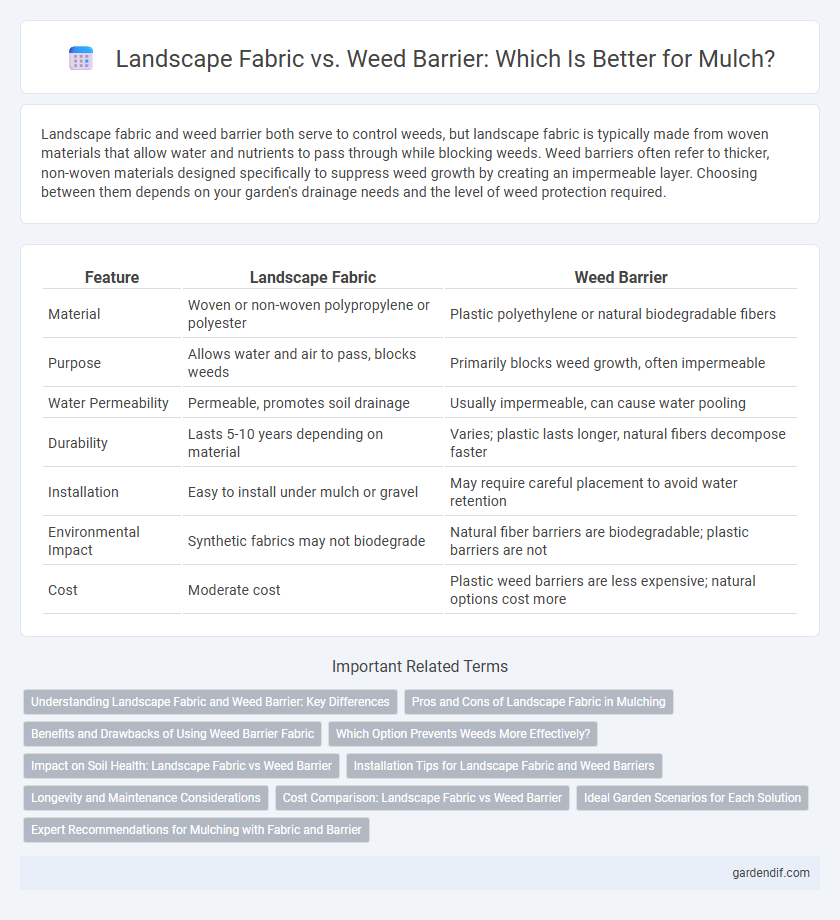
Landscape fabric vs weed barrier Illustration
Landscape fabric and weed barrier both serve to control weeds, but landscape fabric is typically made from woven materials that allow water and nutrients to pass through while blocking weeds. Weed barriers often refer to thicker, non-woven materials designed specifically to suppress weed growth by creating an impermeable layer. Choosing between them depends on your garden's drainage needs and the level of weed protection required.
Table of Comparison
| Feature | Landscape Fabric | Weed Barrier |
|---|---|---|
| Material | Woven or non-woven polypropylene or polyester | Plastic polyethylene or natural biodegradable fibers |
| Purpose | Allows water and air to pass, blocks weeds | Primarily blocks weed growth, often impermeable |
| Water Permeability | Permeable, promotes soil drainage | Usually impermeable, can cause water pooling |
| Durability | Lasts 5-10 years depending on material | Varies; plastic lasts longer, natural fibers decompose faster |
| Installation | Easy to install under mulch or gravel | May require careful placement to avoid water retention |
| Environmental Impact | Synthetic fabrics may not biodegrade | Natural fiber barriers are biodegradable; plastic barriers are not |
| Cost | Moderate cost | Plastic weed barriers are less expensive; natural options cost more |
Understanding Landscape Fabric and Weed Barrier: Key Differences
Landscape fabric is a woven or non-woven material designed to allow water and air passage while suppressing weed growth, making it ideal for long-term garden bed protection. Weed barriers, often made from plastic or rubberized materials, create an impermeable barrier that blocks all light and moisture, effectively preventing weeds but potentially hindering soil health. Understanding these distinctions helps gardeners choose the best option for balancing weed control with soil aeration and water drainage.
Pros and Cons of Landscape Fabric in Mulching
Landscape fabric offers excellent weed control by allowing water and air to penetrate while blocking sunlight that promotes weed growth, making it a durable mulching option. However, it can restrict organic matter from enriching the soil and may degrade over time, requiring replacement. Unlike organic mulches, landscape fabric does not improve soil fertility but reduces the need for frequent maintenance and weed removal.
Benefits and Drawbacks of Using Weed Barrier Fabric
Weed barrier fabric offers significant benefits such as effective weed suppression, moisture retention, and soil temperature regulation, promoting healthier plant growth. However, drawbacks include potential soil compaction, reduced organic matter integration, and limited biodegradability, which can lead to long-term environmental concerns. Choosing the right weed barrier fabric involves balancing these factors based on specific landscape needs and maintenance goals.
Which Option Prevents Weeds More Effectively?
Landscape fabric typically allows water and air to penetrate while blocking sunlight, effectively suppressing weeds by preventing photosynthesis. Weed barriers, often made from thicker plastic, create a stronger physical barrier that completely blocks weed growth but may inhibit water and air flow, potentially harming plant roots. For long-term weed prevention, landscape fabric balances weed suppression with soil health, whereas weed barriers offer more immediate, total obstruction at the risk of soil degradation.
Impact on Soil Health: Landscape Fabric vs Weed Barrier
Landscape fabric allows for better water and air penetration compared to traditional weed barriers, promoting healthier root systems and improved microbial activity in the soil. Weed barriers, often made from thick plastic, can restrict soil aeration and moisture flow, potentially leading to soil compaction and reduced nutrient availability. Selecting breathable landscape fabric supports long-term soil vitality by maintaining natural soil processes essential for plant growth.
Installation Tips for Landscape Fabric and Weed Barriers
When installing landscape fabric, ensure the soil is clean and level to promote effective moisture retention and weed suppression. Overlap fabric edges by at least 6 inches to prevent weed penetration, securing with landscape staples every 12 inches for stability. For weed barriers, choose permeable materials to allow water and air flow, and cut holes precisely for plant placement to maintain barrier integrity and plant health.
Longevity and Maintenance Considerations
Landscape fabric typically offers greater longevity than traditional weed barriers, often lasting up to 10 years when installed correctly, due to its durable woven or non-woven materials. Maintenance considerations favor landscape fabric as it reduces the need for frequent replacement and minimizes weed growth effectively, while traditional weed barriers may degrade faster and require more regular upkeep. Choosing landscape fabric enhances long-term garden health by providing sustained weed control and lowering labor costs associated with maintenance.
Cost Comparison: Landscape Fabric vs Weed Barrier
Landscape fabric typically costs between $0.40 and $1.00 per square foot, offering a durable option that can last several years. Weed barrier materials are generally less expensive, averaging around $0.10 to $0.50 per square foot, but may require more frequent replacement. Factoring in longevity and maintenance, landscape fabric provides better long-term value despite the higher initial investment.
Ideal Garden Scenarios for Each Solution
Landscape fabric excels in garden beds with moderate foot traffic and perennial plants, providing long-term weed control while allowing water and nutrients to reach the soil. Weed barrier is ideal for high-maintenance vegetable gardens or flower beds where frequent planting and soil cultivation occur, as it can be easily removed or replaced. Both solutions enhance garden health by reducing weed growth but should be chosen based on specific garden activities and maintenance frequency.
Expert Recommendations for Mulching with Fabric and Barrier
Experts recommend using landscape fabric beneath mulch to enhance weed control while maintaining soil moisture and aeration. Durable weed barriers provide long-lasting suppression but may hinder water infiltration, making fabric preferable for plant health. Proper installation involves securing fabric edges and layering mulch to maximize effectiveness and promote sustainable landscaping.
Landscape fabric vs weed barrier Infographic

 gardendif.com
gardendif.com